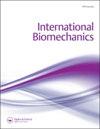后轮轮轴位置对轮椅使用过程中上肢运动和肌电图的影响
Q2 Medicine
引用次数: 5
摘要
摘要手动轮椅推进是下肢残疾人的一种重要活动方式。轮椅配置的变化会影响上肢关节的活动范围、肌肉动作和系统稳定性。本研究的目的是通过应用基于标记的三维运动分析技术,研究调整轮椅配置对身体健全、无经验的手动轮椅使用者上半身关节运动学和肌肉补充的影响。对10名健康男性受试者进行了三种轮椅配置的表征,通过将两个后轮的水平轴位置从制造商设定的原始位置向后调整(3cm)和(6cm)来设定。在加的夫大学运动分析实验室测量了上身关节和肩部肌肉的选定三维运动学和表面肌电图(sEMG)参数。在推进试验中,躯干屈曲/伸展、侧向弯曲和轴向旋转的平均范围分别为(7.50°±1.4°)、(5.91°±1.23°)和(7.01°±3.91°)。主要肩外展/内收、屈曲/伸展和内/外旋的平均范围分别为(24.63°±6.38°)、(17.31°±4.27°)和(40.02°±12.35°)。主要肘关节旋前/旋后和屈伸分别在(15.49°±7.70°)和(34.37°±8.38°)范围内进行评估。主要腕桡/尺侧偏移和屈伸的平均范围分别为(29.82°±8.97°)和(53.59°±9.65°)。通过将肌肉肌电图标准化为MVC活动的百分比,在推进试验期间和三轮调整时,相对于其他主要肩部肌肉,三角肌后部的平均肌电图肌肉活动最高(11.43±5.33)。其他平均肌肉活动评估为:上斜方肌(6.99±2.37)、肱三头肌(6.89±2.51)、三角肌前肌(5.39±2.95)、肱二头肌(3.26±1.00)和胸大肌(3.14±1.26)是最低的平均活动。这项研究的结果表明,后轮轴位置的向后变化与躯干和主要上肢的运动ROM以及主要参与推进恢复阶段的肌肉的sEMG活动的增加有关,这可能与肌肉骨骼疾病的更高风险有关。这些知识可以帮助专业人士设计和处方更适合用户功能特征的轮椅,从而提高他们的生活质量。本文章由计算机程序翻译,如有差异,请以英文原文为准。
Impact of rear wheel axle position on upper limb kinematics and electromyography during manual wheelchair use
Abstract Manual wheelchair propulsion is an important form of mobility for people with lower limb disabilities. Changes in the wheelchair configuration can affect, range of motion (ROM) of the upper limb joints, muscle actions and system stability. The purpose of this study is to investigate the impact of adjusting wheelchair configurations on upper body joints kinematics and muscle recruitment for able-bodied non experienced manual wheelchair users through applying a marker-based 3D motion analysis technique. Ten healthy male subjects were characterised for three wheelchair configurations, set by adjusting the horizontal axle position of both rear wheels by (3 cm) and (6 cm) posteriorly from the original position set by the manufacturer. Selected 3D kinematic and surface electromyography (sEMG) parameters of the upper body joints and shoulder muscles were measured in the Cardiff University Motion Analysis Laboratory. During the propulsion trials, trunk flexion/extension, lateral bending and axial rotation were evaluated within the average range of (7.50°±1.4°), (5.91°±1.23°) and (7.01°±3.91°), respectively. Dominant shoulder abduction/adduction, flexion/extension and internal/external rotation were evaluated within the average range of (24.63°±6.38°), (17.31°±4.27°) and (40.02°±12.35°), respectively. Dominant elbow pronation/supination and flexion/extension were evaluated within the range of (15.49°±7.70°) and (34.37°±8.38°), respectively. Dominant wrist radial/ulnar deviation and flexion/ extension were evaluated within the average range of (29.82°±8.97°) and (53.59°±9.65°), respectively. With normalising the muscle EMG to the percentage of MVC activity, posterior deltoid had the highest average EMG muscle activity (11.43 ± 5.33) during the propulsion trials and at the three wheel adjustments relative to the other dominant shoulder muscles. Other average muscles activities were evaluated as (6.99 ± 2.37) for upper trapezius, (6.89 ± 2.51) for triceps brachii, (5.39 ± 2.95) for anterior deltoid, (3.26 ± 1.00) for biceps brachii and (3.14 ± 1.26) for pectoralis major as the lowest average activity. The findings of this study indicate that changing rear wheel axle position posteriorly is correlated with increasing the kinematic ROMs of the trunk and dominant upper limb and the sEMG activities of the muscles predominantly involved with the recovery phase of propulsion which could be linked with higher risks of musculoskeletal disorders. This knowledge may help professionals when designing and prescribing wheelchairs that are more proper to users’ functional characteristics, accordingly profiting them improved quality of life.
求助全文
通过发布文献求助,成功后即可免费获取论文全文。
去求助
来源期刊

International Biomechanics
Medicine-Rehabilitation
CiteScore
1.90
自引率
0.00%
发文量
2
审稿时长
17 weeks
期刊介绍:
International Biomechanics is a fully Open Access biomechanics journal that aims to foster innovation, debate and collaboration across the full spectrum of biomechanics. We publish original articles, reviews, and short communications in all areas of biomechanics and welcome papers that explore: Bio-fluid mechanics, Continuum Biomechanics, Biotribology, Cellular Biomechanics, Mechanobiology, Mechano-transduction, Tissue Mechanics, Comparative Biomechanics and Functional Anatomy, Allometry, Animal locomotion in biomechanics, Gait analysis in biomechanics, Musculoskeletal and Orthopaedic Biomechanics, Cardiovascular Biomechanics, Plant Biomechanics, Injury Biomechanics, Impact Biomechanics, Sport and Exercise Biomechanics, Kinesiology, Rehabilitation in biomechanics, Quantitative Ergonomics, Human Factors engineering, Occupational Biomechanics, Developmental Biomechanics.
 求助内容:
求助内容: 应助结果提醒方式:
应助结果提醒方式:


